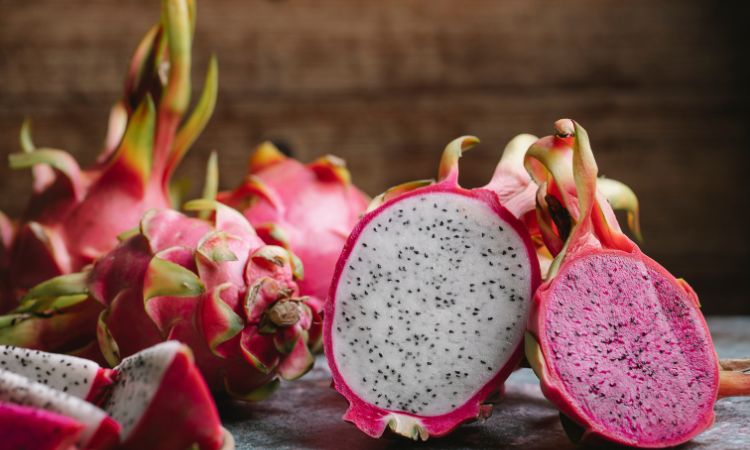Dragon fruit, with its vibrant colors and unique appearance, has gained popularity as a delicious and exotic tropical fruit. However, like many fruits, dragon fruit has its own seasonality, which affects its availability and quality. In this comprehensive guide, we will explore the factors influencing dragon fruit’s seasonality, understand the regions where it thrives, and provide helpful tips for buying and enjoying this delightful fruit.
Understanding Dragon Fruit:

Dragon fruit, also known as pitaya, is a tropical fruit belonging to the cactus family. It features a vibrant exterior with scales, ranging in colors from pink, yellow, and red to white. The fruit’s flesh is either white or magenta, speckled with tiny black seeds. Dragon fruit comes in different varieties, including the white-fleshed Hylocereus undatus, the red-fleshed Hylocereus polyrhizus, and the yellow-fleshed Selenicereus megalanthus.
When Are Dragon Fruit in Season?
In the United States, dragon fruit is primarily in season during the summer months. In states like California and Florida, the peak season for dragon fruit is typically from June to September. However, with advancements in agricultural practices and greenhouse cultivation, dragon fruit may be available in certain regions year-round. It’s always best to check with local farmers’ markets or grocery stores for the most accurate and up-to-date information on dragon fruit availability in your area.
Factors Affecting Seasonality:
Several factors contribute to dragon fruit’s seasonality:
A. Geographical considerations: Dragon fruit grows best in tropical and subtropical regions.
B. Climatic conditions: Optimal temperature, rainfall, and sunlight influence fruit development.
C. Growing methods: Cultivation in open fields or greenhouses affects the fruit’s seasonal availability.
D. Harvesting and storage practices: Proper timing of harvest and appropriate storage conditions determine fruit quality and shelf life.
Dragon Fruit Seasonality by Region:
Dragon fruit cultivation is prominent in various regions worldwide. Here are some key areas and their respective seasons:
A. Southeast Asia:
Vietnam: Main season from June to December.
Thailand: Peak season from May to November.
Philippines: Harvest period from August to November.
B. Central and South America:
Mexico: Peak season from May to September.
Colombia: Main season from February to June.
Ecuador: Harvest period from January to April.
C. United States and other countries:
California: Harvesting occurs from June to November.
Florida: Peak season from June to September.
Israel: Main season from September to February.
Australia: Harvest period from December to April.
Understanding the Harvest Period:
Dragon fruit goes through specific stages before it is ready for harvest:
A. Flowering and pollination process: The plant produces large, fragrant flowers that require proper pollination to set fruit.
B. Fruit development stages: After successful pollination, the fruit begins to grow and ripen over a specific period.
C. Timing of harvest: Harvesting occurs when the fruit reaches its optimal ripeness, which varies depending on the variety and region.
Also Read – Gala vs. Fuji Apples: Exploring the Differences and Delights
Seasonality Variations and Availability:
A. Primary season and peak months: The regions mentioned earlier have their primary seasons and specific months when dragon fruit is abundant and of high quality.
B. Off-season availability: With advancements in agricultural practices, dragon fruit can be cultivated year-round in certain regions, enabling off-season availability.
C. Market availability and import/export dynamics: Dragon fruit may be imported or exported between regions to meet consumer demands throughout the year.
Seasonal Buying Tips:
To ensure you select the best dragon fruit:
A. Identifying ripe dragon fruit: Look for vibrant color, slightly firm flesh with a slight give, and fresh-looking scales.
B. Storage and shelf life recommendations: Dragon fruit is best consumed soon after purchase. If storing, keep it in a cool, dry place or refrigerate for a few days.
C. Farmers’ markets vs. grocery stores: Consider purchasing dragon fruit from local farmers’ markets for fresher and potentially seasonal produce.
Culinary Uses and Recipes:
Dragon fruit’s mild, subtly sweet flavor and visually appealing appearance make it a versatile ingredient. Some popular ways to consume dragon fruit include:
A. Eating it fresh: Simply scoop out the flesh with a spoon and enjoy it on its own.
B. Adding to fruit salads: Dragon fruit adds a delightful pop of color and flavor to fruit salads.
C. Blending in smoothies: Blend dragon fruit with other fruits and liquids to create vibrant and nutritious smoothies.
D. Creating refreshing beverages: Dragon fruit can be used to make flavorful juices, cocktails, and mocktails.
Recipe Ideas for Each Season:
Explore seasonal recipes to make the most of dragon fruit’s availability throughout the year. For example:
A. Summer: Dragon fruit popsicles, tropical fruit skewers with dragon fruit dipping sauce.
B. Fall: Dragon fruit salsa, dragon fruit and apple crisp.
C. Winter: Dragon fruit and citrus salad, dragon fruit smoothie bowls.
D. Spring: Dragon fruit and strawberry tart, dragon fruit lemonade.
Conclusion:
Understanding dragon fruit’s seasonality is essential for enjoying this exotic fruit at its peak. By considering geographical factors, regional availability, and proper harvesting practices, you can make informed choices when purchasing dragon fruit.
Remember to explore the diverse culinary possibilities that dragon fruit offers and savor its flavors throughout the seasons. So, embrace the beauty of dragon fruit, indulge in its goodness, and make the most of each season’s bounty.



